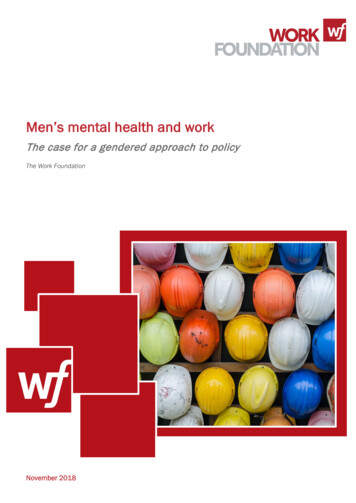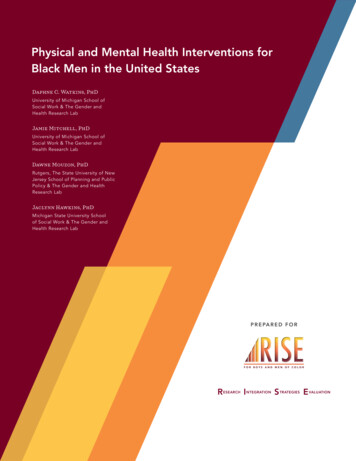
Transcription
Men’s mental health and workThe case for a gendered approach to policyThe Work FoundationNovember 2018
About the Work FoundationThrough its rigorous research programmes targeting organisations, cities, regions andeconomies, now and for future trends, the Work Foundation is a leading provider of analysis,evaluation, policy advice and know-how in the UK and beyond.The Work Foundation addresses the fundamental question of what Good Work means: this isa complex and evolving concept. Good Work for all by necessity encapsulates the importanceof productivity and skills needs, the consequences of technological innovation, and of goodworking practices. The impact of local economic development, of potential disrupters to workfrom wider-economic governmental and societal pressures, as well as the business-needs ofdifferent types of organisations can all influence our understanding of what makes work good.Central to the concept of Good Work is how these and other factors impact on the well-beingof the individual whether in employment or seeking to enter the workforce.For further details, please visit www.theworkfoundation.com.About the Health at Work Policy UnitThe Health at Work Policy Unit (HWPU) provides evidence-based policy recommendationsand commentary on contemporary issues around health, wellbeing and work. Based at theWork Foundation, it draws on the Foundation’s substantial expertise in workforce health, itsreputation in the health and wellbeing arena and its relationships with policy influencers. TheHWPU aims to provide an independent, authoritative, evidence-based voice capable ofarticulating the views of all stakeholders.AcknowledgementsThis paper was written by a team at the Work Foundation comprising Dr James Chandler,Heather Carey, Cicely Dudley, Jenna Kerns and Karen Steadman. We would like to thank allof the individuals and organisations involved in the research for their valuable input.This paper has been supported financially by grants from the British Safety Council and NappPharmaceuticals Limited who have had no editorial input.Picture creditsCover: Pexels
Men’s mental health and work: the case for a gendered approach to policyExecutive summaryBackgroundGender and sex have a considerable effect on individuals’ experience of the workplace andhealth. While a lot of attention has been given to female emancipation over the last century,and the effect of women’s increasing participation in the labour force on their lives, perhapsless attention is given to the changes that male workers have seen during the same period.On the face of it, it may seem that the ‘average’ man in the UK has not experienced the samerate of change as the average woman, but scratch a little deeper and we see rapid and, often,significant changes to men’s experience of work, with attendant implications for their healthand wellbeing.Men’s and women’s health differs in a number of ways. These differences are created andreinforced by the type of work that men and women typically do. Men, for example, are morelikely to do physically dangerous work. Furthermore, male-dominated sectors, such asconstruction, have disproportionately high rates of suicide. In many cases, exposure to theserisks conspires with men’s apparent reticence to engage with health services – with inevitablybad implications for their health and wellbeing.These inequalities have clear and important implications for government policy.This paper assesses some of the structural changes over recent decades that have influencedmen’s role in the labour market and the implications this has had for their health – and how toaddress them. This has been informed by the academic and grey literature, and byconversations with a number of expert interviewees. Although not all of the issues highlightedare unique to men – nor relevant to all men – for this paper we look explicitly through a ‘malelens’ in order to better understand where there might be a need for specific approaches andsupport.Key messagesIt is clear that changes to the UK labour market in recent decades have created apredominantly male displaced workforce which, by and large, has struggled to either find workof similar quality or any work at all. Work is considered central to male masculinity and, assuch, these structural changes have had significant implications for men’s mental health.Furthermore, men often work in jobs that pose threats to their physical health and safety,frequently characterised by low pay and insecurity, requiring them to work for extendedperiods away from family. All of this poses particular challenges for men’s physical and, inparticular, mental health.To a large extent, the health problems presented by the changes to and the type of work thatmen typically do are compounded by the way in which they handle it.Men, relative to women, are reluctant to express concerns about their mental health andengage with professional help. They are also significantly more likely to engage in risky healthybehaviours, e.g. alcohol and drug abuse, and are disproportionately affected by suicide.Furthermore, they are less likely to visit a GP, attend an NHS health check, get screened foriii
cancer, visit a pharmacy or have a sexual health test 1. They are also less likely to seek helpfor a mental health problem. Reasons for low levels of engagement are complex and moreresearch is needed. However, cultural barriers have been cited, e.g. seeking help is not‘masculine’, as well as practical barriers, e.g. being unable to fit GP appointments around workor working away from home preventing access to the local GP.There are clear differences between men and women regarding how they experience andmanage mental ill health. This has important implications for the type of support that menneed.There are several examples – in the UK and internationally – of good practice seeking toaddress the need for appropriate services that promote men’s mental health (in and out ofwork) and support those who experience poorer mental health. Whether they aim to stimulatepeer interaction, promote engagement with health services, de-stigmatise mental health oroperationalise a ‘gendered’ approach to health, they share a similar aim: improving mentalhealth outcomes for men. Our recommendations, set out below, draw on these examples andthe evidence presented throughout the paper.RecommendationsThe evidence suggests that there may be a need to look at mental health and related supportservices through a ‘male lens’, incorporating the role of work as an important influence, andthe workplace as a setting for providing support.What should employers do?Workplace support, provided by services such as Employee Assistance Programmes andOccupational Health services, can effectively deal with employee health and wellbeing issues.However, the issues they typically tackle – mental health problems including anxiety anddepression – are issues that men are reluctant to seek help for. Thus, these services shouldbe communicated to male workforces in a manner that will resonate with them. Terms like‘mental ill health’ carry connotations that alienate men. These services should be presentedas tackling ‘stress’ – or, rather than focusing on mental health specifically, focus on healthgenerally, i.e. physical and mental, rather than just mental health (creating parity).In addition, consideration should be given by employers in certain sectors, particularlyconstruction, regarding the likely impact that the nature of the work will have on their(predominantly male) workforce’s health.What should health services/providers do?Currently, we don’t know enough about the effectiveness of gendered approaches tohealthcare, or the full extent of the differences in health experienced by men and women.Many support services do not differentiate outcomes by gender – they simply do not collectthese data. Gendered outcomes of services in data collection and evaluation should,therefore, be prioritised. Within this, we argue that work should be recognised as a healthoutcome. This has potential benefits for both men and women, but it is arguably of greaterimportance for men given that their mental health – self-confidence, esteem, etc. – isMen’s Health Forum. (2017). Men’s Health Manifesto. Retrieved lt/files/pdf/mens health manifesto lr.pdf1iv
Men’s mental health and work: the case for a gendered approach to policyapparently contingent on not just whether they are in work or not, but the status and prestigeattached to it.What should government do?Based on a review of the literature and conversations with a number of key informants, wemake four broad policy recommendations. To improve men’s health outcomes,Government should:1.2.3.4.Re-think policy design;develop awareness, understanding and engagement;improve access and support; andbuild the evidence-base.Re-think policy designPolicy models should be re-designed for ‘gendered’ health interventions. A ‘universalhealth strategy’ should focus on general physical and mental health promotion, including theimportance of a healthy diet, physical activity and stress reduction. It should be supported bytwo ‘strands’, one focused on women and health conditions affecting them (e.g. reproductiveand gynaecological health conditions) and another focused on men and the conditions thattypically affect them, including drug and alcohol abuse, suicide.Furthermore, specific policies should be targeted at groups considered to be at ‘highrisk’ of mental ill health, engagement in adverse health behaviours, and suicide. Theseinclude: unemployed men, those aged 45-59, men working in high-risk sectors (e.g.construction), men experiencing relationship breakdown and those in the criminal justicesystem.Develop awareness, understanding and engagementGiven men’s reluctance to engage with health services, the onus is on government totake a proactive stance and reach out to them. Targeted health campaigns inpredominantly male settings (e.g. male-dominated workplaces, public houses, sports grounds,betting shops, etc.) should be prioritised.Government should work with employer groups, the criminal justice system, and theemergency care services to extend the scope of occupational health services to includescreening and preventative health measures. ‘Mental health diversion’ schemes, whichoperate at the interface between criminal justice and mental health, should be expanded.Government should also explore ways of increasing health check outreach and uptakeamongst men.Marketing strategies for mental health services should be re-designed with men in mind. TheDepartment of Health and Social Care (DHSC) and relevant third sector organisations shouldexplore ways in which they can re-brand services in ways that resonate with men. Materialsshould use more accessible and less alienating terminology. The DHSC should consider creating resources like ‘Stress Manuals’ and ‘WellbeingManuals’ detailing how to identify and treat stress and mental health conditions.Suicide prevention and mental health treatment should not be a ‘last resort’. Emphasison early intervention and – ideally – prevention should be considered a priority.v
Government should prioritise tackling the stigma associated with mental health by putting iton an equal footing with mental health, creating ‘parity of esteem’. Mental health should notnecessarily be distinguished from physical health but treated as just one dimension of healthand wellbeing.Improve access and supportTo improve men’s access to general and mental health services and support, thefeasibility of ‘out of hours’ and ‘after hours’ services should be explored bygovernment. Too often, access to services is prohibited by inflexible opening times that donot accommodate full-time workers.Government should promote greater use of self-help groups, peer-led support and provideout-of-hours support and walk-in clinics (e.g. with counsellors and mental health support).Mental health episodes cannot be accurately predicted therefore the ability to access servicesquickly is of vital importance.Build the evidence-baseGovernment should commission new research to help build the evidence-base on thecauses of poor mental health and suicide in men, especially for high-risk groups. Suicidedisproportionately affects men more than women in the UK, though the reasons why are notfully understood.Finally, there is a need for more impact assessments and evaluations of health services,interventions and policies. Many services, interventions and policies – particularly mentalhealth ones – do not differentiate outcomes by gender. It is therefore difficult to appreciate thedifferential impact that these services have on women and men, and, in turn, design policy toaddress gender-specific issues.vi
Men’s mental health and work: the case for a gendered approach to policyContents1. Introduction .11.1.The context . 11.2.This paper . 22. Men and work.32.1.Changes to the UK labour market and their implications . 32.2.‘Risky business’: do ‘men’s jobs’ pose a greater mental health risk? . 62.3.Can men really ‘have it all’? . 72.4.Key messages . 83. Men and mental health .93.1.Distinctions between men’s and women’s mental health . 93.2.Dr Who? Men and disclosure/help seeking . 133.3.Key messages . 134. Good practice in promoting men’s health . 144.1.Promoting health through peer interaction and ‘meaningful activity’ . 144.2.Promoting engagement with health services . 144.3.De-stigmatising men’s mental health . 154.4.A men’s health policy . 164.5.Key messages . 175. Conclusions and recommendations. 185.1.What should employers do? . 185.2.What should health services/providers do? . 195.3.What should government do? . 205.4.Re-think policy design . 205.5.Develop awareness, understanding and engagement . 225.6.Improve access and support . 235.7.Build the evidence-base . 245.8.Final comment . 24List of FiguresFigure 2.1 – Percentage of the labour force working in each sector of the economy, Englandand Wales, 1841 to 20114Figure 3.1 – Prevalence of illicit drug use, by age and sex10Figure 3.2 – Age-standardised suicide rates by sex, for the UK, registered between 1981 and201611vii
Figure 5.1 – A universal health strategy21List of BoxesBox A – The context: men’s mental health and wellbeing . 1Box B – Male groups at high risk of adverse health and health-related outcomes . 21viii
Men’s mental health and work: the case for a gendered approach to policy1.Introduction1.1.The contextGender and sex have a considerable effect on individuals’ experience of the workplace andhealth. While a lot of attention has been given to female emancipation over the last century,and the effect of women’s increasing participation in the labour force on their lives, perhapsless attention is given to the changes that male workers have seen during the same period.On the face of it, it may seem that the ‘average’ man in the UK has not experienced the samerate of change as the average woman, but scratch a little deeper and we see rapid and, often,significant changes to men’s experience of work, with attendant implications for their healthand wellbeing.Men’s and women’s health differs in a number of ways (see Box A below for an overview).These differences are created and reinforced by the type of work that men and womentypically do. Men, for example, are more likely to do physically dangerous work. Furthermore,male-dominated sectors, such as construction, have disproportionately high rates of suicide.In many cases, exposure to these risks conspires with men’s apparent reticence to engagewith health services – with inevitably bad implications for their health and wellbeing.These inequalities have clear and important implications for government policy.Box A – The context: men’s mental health and wellbeing 2 One adult in six (17%) has a common mental disorder (CMD), e.g. depression, anxiety,phobia, obsessive compulsive disorder and panic disorder. One woman in five hasCMD (20.7%) compared with about one man in eight (13.2%). Nearly half of adults (43.4%) think that they have had a mental disorder at some point,35.2% of men and 51.2% of women. A fifth of men (19.5%) and a third of women(33.7%) have also had diagnoses confirmed by a professional. Both drug and alcohol dependence were twice as likely in men as women. Reports of self-harming doubled in men and women and across age groups between2007 and 2014 (though it should be pointed out that changes in reporting may accountfor some of the increase). Since 2007, there had been increases in CMD symptoms in late midlife men and women(aged 55 to 64). Men aged 55-64 have the highest rates of registered suicide 3. Over half of men (54.6%) in receipt of Employment Support Allowance (ESA) have aCMD – as do over three quarters of women in receipt of ESA (77.9%). Just under half of men (45%) on any out of work benefit have a CMD, and more thanone in three (38%) of those in receipt of housing benefit.McManus, S., Bebbington, P., Jenkins, R., & Brugha, T. (2016). Adult Psychiatric Morbidity Survey: Survey of Mental Healthand Wellbeing, England, 2014. Leeds: NHS Digital, 1–405.3Thomas, K., & Gunnell, D. (2010). Suicide in England and Wales 1861-2007: A time-trends analysis. International Journal ofEpidemiology, 39(6), 1464–1475.21
1.2.This paperThis paper assesses some of the structural changes over recent decades that have influencedmen’s role in the labour market and the implications this has had for their health – and how toaddress them. This has been informed by the academic and grey literature, and byconversations with a number of expert interviewees. Although not all of the issues highlightedare unique to men – nor relevant to all men – for this paper we look explicitly through a ‘malelens’ in order to better understand where there might be a need for specific approaches andsupport.In the first chapter we consider men’s changing role in the world of work, i.e. the changes tothe UK labour market and the implications for the male workforce. This is followed by anassessment of men’s mental health, how this contrasts with women’s mental health and men’srelatively higher propensity for engaging in risky health behaviours and suicide, as well theirreticence to seek help. In the third chapter we explore what support is available to men fortheir health and wellbeing, drawing on best practice examples from around the world. We thendiscuss what employers, health services/providers and government can do to better supportmen, before outlining our recommendations.This paper is the second in our Gender, sex, health and work series, which explores theissue of health and work through a ‘gendered’ lens. This series focuses on areas where genderand sex have a significant impact on work and/or health outcomes. Other papers in the seriesinclude: More than ‘women’s issues’: women’s reproductive and gynaecological health andworkManaging migraine: a women’s health issue?Who cares? The implications of informal care and work for policymakers andemployersFor more information, see our background paper and accompanying infographics.2
Men’s mental health and work: the case for a gendered approach to policy2.Men and work2.1.Changes to the UK labour market and their implicationsThe globalisation of world trade and subsequent changes to the UK labour market haveaffected people’s daily lives and their access to employment 4. Though there are many benefitsof globalisation for the individuals of countries across the world 5, these structural changeshave had far reaching implications, including changes to the viability of local industry 6.Over the past four decades, the UK labour market has seen considerable shifts due toglobalisation and technological change; tying the UK’s economic fate to a global economy.This change came on top of a period of wider deindustrialisation across the UK which hasseen many factories and centres of manufacturing relocate overseas to access cheaper labourand reduce operating costs 7.The number of UK workers employed in heavy industry – in sectors such as mining,manufacturing and steel production – has collapsed. In 1952, 40% of the workforce wasemployed in manufacturing 8; by 2017, this had dropped to around 9% 9. In 2005-10 alone,600,000 manufacturing jobs disappeared and although the sector still accounts for around atenth of GDP, this has fallen in recent years 10. During this period, we saw large, high profilebusinesses/works being shut down, with subsequent clusters of unemployment.The biggest falls in output, and therefore the biggest impact, were seen in the North of Englandand in Wales – areas which have long struggled economically – even before this period ofindustrial decline 11.But why is this a gendered issue? Heavy industry has historically been a male-dominatedsector – this is still true today, albeit to a lesser extent 12. Consequently, the sector’s declineand subsequent widespread job losses were predominantly felt by the male workforce. Whatjobs – if any – replaced these, and who filled them? Workers were not necessarily all “scoopedup” by what came next 13; the subsequent growth of the service sector (see Figure 2.1 below)did not necessarily fill this gap. Indeed, while 79% of UK GDP came from the service sectorDiamond, P. (2010). How globalisation is changing patterns of marginalisation and inclusion in the UK. Retrieved usion-full.pdf5Autor, D. H., Dorn, D., & Hanson, G. H. (2016). The China Shock: Learning from Labor-Market Adjustment to Large Changesin Trade. Annual Review of Economics, 8(1), 205–240.6Ibid.7Hanley, T. (2011). Globalisation, UK poverty and communities. Retrieved mmary.pdf.8Comfort, N. (2012). The Slow Death of British Industry: a 60 year Suicide, 1952-2012. London: Biteback Publishing.9Office for National Statistics. (2017). EMP13: Employment by industry. Retrieved s/employmentbyindustryemp1310The Economist. (2016). Britain’s manufacturing sector is changing beyond all recognition. Retrieved l-recognition11Industrial Communities Alliance. (2007). The other half of Britain. Retrieved ploads/2/6/2/0/2620193/the other half of britain.pdf12Perrons, D. (2009). Women and Gender Equity in Employment Patterns, Progress and Challenges. Institute of EmploymentStudies, (WP23), 1–23.13Autor, et al. (2016).43
in 2014 14,15, its workforce has traditionally been predominantly female, in contrast to maledominated manufacturing 16.Figure 2.1 – Percentage of the labour force working in each sector of the economy, England and Wales,1841 to 2011Source: 2011 Census Analysis, Office for National StatisticsMen with lower levels of education and formal skills tend to find structural labour marketchanges particularly difficult to adapt to 17; many (despite having worked their way up in theindustry) struggle to transfer their experience and find a job of the same status and wage in adifferent sector 18. In the case of manufacturing closures, a significant drop in earnings forformer employees is not unusual, and nor is it temporary; this was demonstrated in Stern’sstudy of plant closures in the US in the 1960s and 70s 19. More recently in the UK, a study ofthe closure of an MG Rover site in the West Midlands found that the labour market status ofthe 91% male workforce was damaged for a considerable period of time: six months afterbeing laid off (although two-thirds had found new jobs) 40% saw their new role as a ‘stop-gap’on the path to a better quality job (i.e. where they felt valued and enjoyed their work), and theThe service sector includes retail, banks, hotels, real estate, education, health, social work, transport, computer services,recreation, media, communications, electricity, gas and water supply.15Office for National Statistics. (2016). Five facts about. The UK service sector. Retrieved from rvice-sector/16Office for National Statistics. (2013). Women in the labour market: 2013. Retrieved s/womeninthelabourmarket/2013-09-2517Autor, et al. (2016).18Ibid.19Stern, J. (1972). Consequences of Plant Closure. The Journal of Human Resources, 7(1), 3-25.144
Men’s mental health and work: the case for a gendered approach to policymajority were earning significantly less than they had been at MG Rover ( 3,523 less a yearon average) 20.In addition to the financial penalties of such change, there may also be social penalties. Withthe traditional role of men as ‘breadwinner’, it has been suggested that male identity is moreintertwined with, and dependent on, work than it is for women 21. Work is therefore consideredto be central to masculine identities, roles and relations 22. As such, shifts in employment whichimpact on financial status, but also perceived work status (i.e. in terms of work quality, valueand ‘prestige’), could have implications for self-esteem, wellbeing and – ultimately – health.The case of MG Rover offers some support for this interpretation: workers who perceived theirnew job as ‘worse’ quality than their previous one at MG Rover role reported higher anxiety 23.Anxiety levels were higher still for those who had not found work 24. It is well known thatunemployment has a strong, causal association with poorer mental health 25,26. In 2014 anestimated 25% of unemployed men had a common mental health condition 27, and unemployedmen are at a substantially higher risk of suicide than their employed counterparts 28 .Furthermore, unemployment may have more of an effect on the mental health of men thanwomen 29. It has been suggested that in the event of job loss it may be easier for women toreplace the emotional rewards of work with family roles than men, resulting in less emotionaldistress 30. In contrast, for men, work is more directly associated with a ‘provider role’ 31. Wealso see a relationship for men between length of unemployment and poorer mental healththat we do not see as clearly for women. Poor mental health is, therefore, comparatively abigger barrier to work for men than it is for women 32. This should inform and shape the designof return to work policy.The quality of work also impacts on mental health 33. Prolonged economic instability in the UKover the past few decades has reduced access to fulfilling, sustainable paid work; somesuggest this has increased men’s propensity to develop mental health problems 34. Indeed,mental illness has increased over the last decade for men who are in – as well as out – ofwork 35. There is in fact evidence that, for men, income level can influence perceived or actualArmstrong, K. (2006). Life after MG Rover: the impact of the closure on the workers, their families and the community.London: The Work Foundation.21Fryers, T. (2006). Work, identity and health. Clinical Practice and Epidemiology in Mental Health, 2.22Oliffe, J., & Han, C. (2014). Beyond Workers’ Compensation Men’s Mental Health In and Out of Work. American Journal ofMen’s Health, 8, 45–53.23Armstrong (2006).24Ibid.25Waddell, G., & Burton, A. (2006). Is Work Good for Your Health and Well-Being? London: The Stationery Office.26Jefferis, B. J., Nazareth, I., Marston, L., Moreno-Kustner, B., Bellón, J. ángel, Svab, I., King, M. (2011). Associationsbetween unemployment and major depressive disorder: Evidence from an international, prospective study (the predict cohort).Social Science and Medicine, 73(11), 1627
address the need for appropriate services that promote men’s mental health(in and out of work) and support those who experience poorer mental health. Whether they aim to stimulate peer interaction, promote engagement with health










